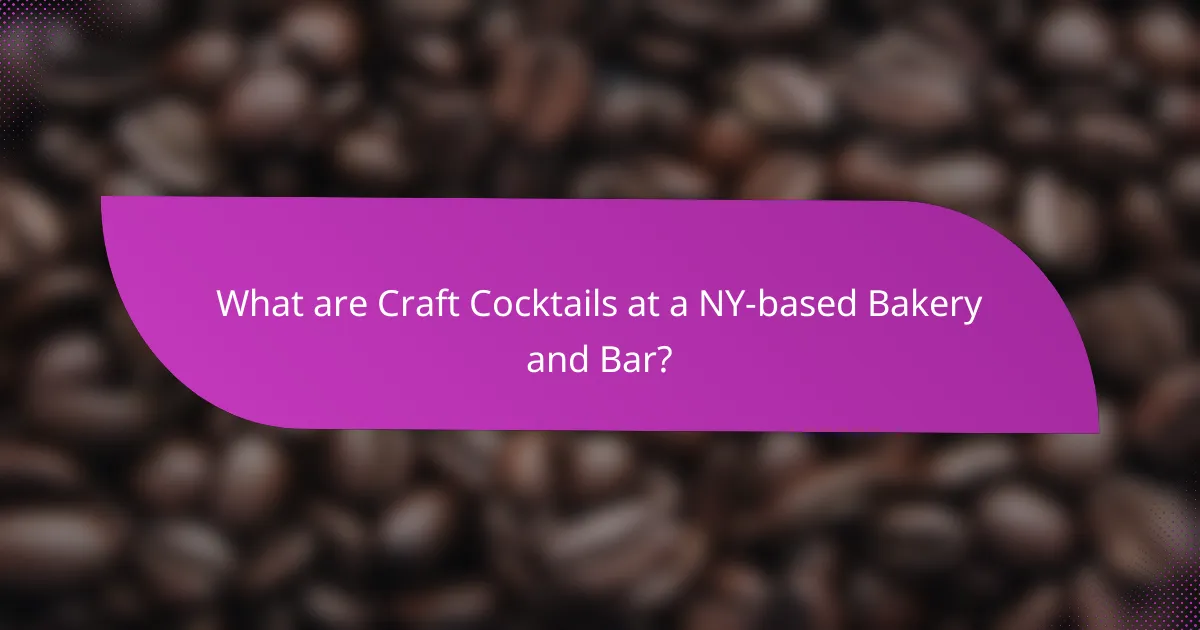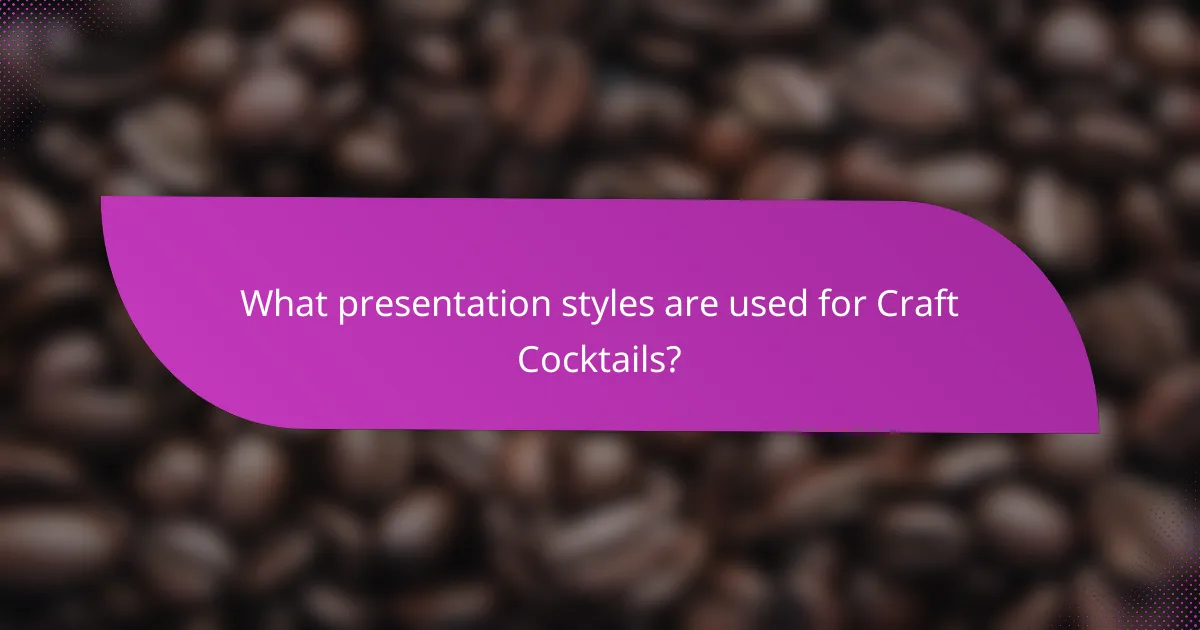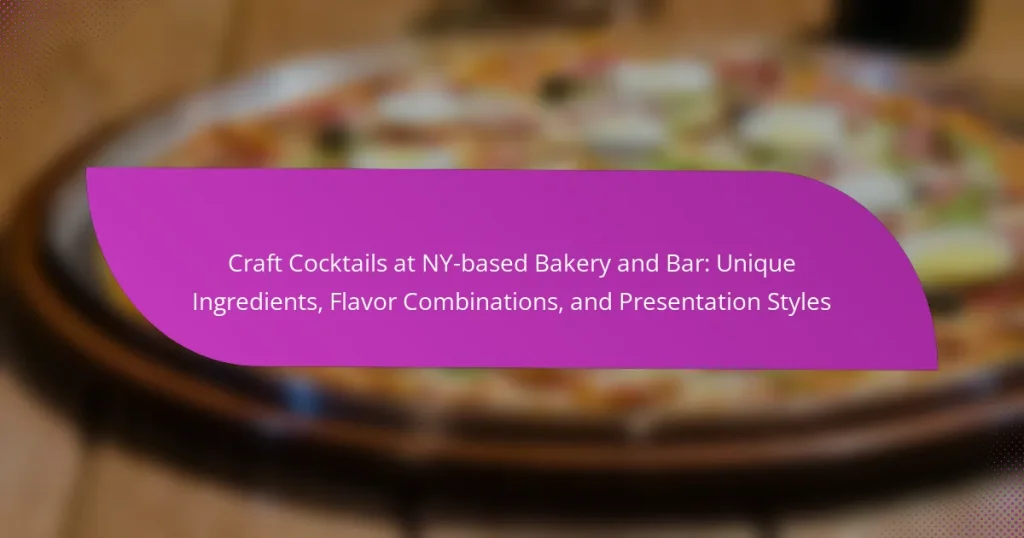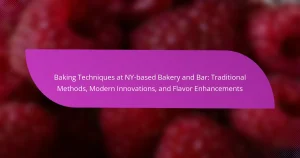Craft cocktails at a New York-based bakery and bar are artisanal beverages crafted with high-quality ingredients, featuring unique flavor combinations that enhance the drinking experience. The cocktails emphasize creativity, incorporating fresh herbs, house-made syrups, and seasonal fruits, with distinctive presentation styles that include elegant glassware and creative garnishes. This article explores the trends in craft cocktails, highlighting the pairing of these drinks with baked goods for a complementary flavor experience. It also discusses various presentation techniques that elevate the visual appeal and enjoyment of cocktails, along with tips for savoring these beverages in an optimal setting.

What are Craft Cocktails at a NY-based Bakery and Bar?
Craft cocktails at a NY-based bakery and bar are artisanal drinks made with high-quality ingredients. These cocktails often feature unique flavor combinations that enhance the drinking experience. The emphasis is on creativity, using fresh herbs, house-made syrups, and seasonal fruits. Presentation styles are also distinctive, often incorporating elegant glassware and garnishes. This approach elevates traditional cocktail-making into a culinary art form. Many establishments focus on pairing these cocktails with baked goods for a complementary flavor experience. The trend reflects a growing interest in craft beverages within the culinary landscape of New York.
How do Craft Cocktails differ from traditional cocktails?
Craft cocktails differ from traditional cocktails in their emphasis on quality and creativity. Craft cocktails use fresh, high-quality ingredients and often incorporate unique flavor combinations. Traditional cocktails typically rely on established recipes and standard ingredients. Craft cocktails prioritize artisanal techniques, such as house-made syrups and infusions. This attention to detail enhances the overall drinking experience. The craft cocktail movement has gained popularity in recent years, reflecting a shift in consumer preferences towards more personalized and innovative drinks. Many craft cocktail bars focus on seasonal ingredients, further differentiating them from traditional cocktail offerings.
What unique attributes define Craft Cocktails in this setting?
Craft cocktails in this setting are defined by their innovative use of unique ingredients. These cocktails often incorporate locally sourced fruits and herbs. The flavor combinations are carefully crafted for a balanced taste experience. Each cocktail showcases artisanal techniques, such as house-made syrups or infusions. Presentation styles are visually striking, often using unconventional glassware or garnishes. Seasonal themes influence the cocktail menu, reflecting the bakery’s offerings. The emphasis on quality ingredients ensures a premium drinking experience. Additionally, the cocktails are often tailored to complement the bakery’s food pairings.
Why are Craft Cocktails gaining popularity in bakeries and bars?
Craft cocktails are gaining popularity in bakeries and bars due to their unique flavor profiles and artisanal preparation. Consumers increasingly seek distinctive experiences that combine food and drink. Bakeries and bars are creatively blending ingredients to enhance taste and presentation. This trend caters to a growing demand for high-quality, handcrafted beverages. According to a 2022 industry report, craft cocktails have seen a 25% increase in sales over the past three years. Establishments that offer these drinks often attract a diverse clientele. The fusion of baking and cocktail culture creates innovative pairings that enhance both experiences. Ultimately, craft cocktails reflect a broader movement towards culinary creativity and personalization in dining.
What role do unique ingredients play in Craft Cocktails?
Unique ingredients play a crucial role in craft cocktails by enhancing flavor complexity and creating distinct profiles. These ingredients often include rare spirits, artisanal mixers, and fresh herbs. Their unique qualities can elevate a drink from ordinary to extraordinary. For instance, using house-made syrups or infusions adds depth and personalization to the cocktail. This approach allows bartenders to showcase creativity and innovation. Additionally, unique ingredients can cater to specific tastes and preferences, making cocktails more appealing to diverse audiences. The incorporation of local and seasonal ingredients also supports sustainability and community engagement. Overall, unique ingredients are essential for crafting memorable and distinctive cocktails that stand out in a competitive market.
How are ingredients sourced for these Craft Cocktails?
Ingredients for craft cocktails are sourced from local farms and artisanal producers. This approach ensures freshness and quality. Seasonal fruits, herbs, and spices are often used to enhance flavors. The bar prioritizes sustainable and organic options whenever possible. Collaborations with local suppliers support the community. For example, partnerships with nearby farms provide unique, fresh ingredients. This sourcing method contributes to the overall flavor profile of the cocktails. It also aligns with the growing trend of farm-to-table practices in the beverage industry.
What are some examples of unique ingredients used in these cocktails?
Unique ingredients in craft cocktails include activated charcoal, lavender syrup, and smoked rosemary. Activated charcoal adds a striking black color and detoxifying properties. Lavender syrup contributes floral notes and enhances aroma. Smoked rosemary infuses a savory element, creating depth in flavor profiles. These ingredients elevate the cocktail experience through unique tastes and visual appeal.
How do flavor combinations enhance Craft Cocktails?
Flavor combinations enhance craft cocktails by creating complex and balanced taste experiences. They allow for the interplay of sweet, sour, bitter, and umami flavors. This complexity engages the palate and elevates the drinking experience. For example, a cocktail with citrus and herbal notes can provide freshness and depth. Combining ingredients like spicy and sweet can create a harmonious contrast. Additionally, unique flavor pairings can surprise and delight consumers. Research shows that cocktails with well-thought-out flavor combinations are more likely to be memorable. This memorability can lead to repeat orders and customer loyalty. Flavor combinations also allow for creativity and personalization in cocktail crafting.
What are the principles behind creating balanced flavor profiles?
Creating balanced flavor profiles involves harmonizing sweet, sour, bitter, salty, and umami tastes. Each flavor contributes to the overall experience of a cocktail. Sweetness can soften acidity and bitterness. Sourness adds brightness and contrast to sweetness. Bitterness provides depth and complexity. Salt enhances flavors and can balance sweetness. Umami adds richness and fullness.
Using fresh ingredients is crucial for achieving balance. Fresh herbs, fruits, and spices can elevate flavors. Understanding the interaction between flavors is essential. For example, citrus can enhance the perception of sweetness.
Experimentation is key to finding the right balance. Tasting and adjusting ingredients during the mixing process helps achieve desired results. Knowledge of classic flavor pairings can guide the creation of balanced profiles.
In summary, balance is achieved through the careful combination of flavor elements, fresh ingredients, and an understanding of flavor interactions.
How do seasonal ingredients influence flavor combinations?
Seasonal ingredients significantly influence flavor combinations by providing fresh, vibrant flavors that align with specific times of the year. These ingredients often reflect the natural growing cycles, leading to unique pairings that enhance taste profiles. For example, summer ingredients like berries and citrus introduce bright, refreshing notes. In contrast, winter ingredients such as spices and root vegetables add warmth and depth. The use of seasonal produce can also create a sense of place and time, connecting consumers to local agriculture. This practice not only enhances flavor but also promotes sustainability by reducing transportation emissions. Seasonal menus often attract customers looking for unique and fresh experiences. According to a study published in the Journal of Culinary Science & Technology, seasonal ingredients can elevate dishes by up to 30% in perceived flavor quality.

What presentation styles are used for Craft Cocktails?
Craft cocktails are presented in various styles that enhance their visual appeal and overall experience. Common presentation styles include classic glassware, such as coupe glasses and highball glasses. Unique garnishes, like fresh herbs or edible flowers, are often used to add color and aroma. Layering techniques create visually striking drinks, showcasing different colors and textures. Creative ice shapes, such as spheres or large cubes, are utilized to maintain temperature and aesthetics. Additionally, themed glassware can reflect the cocktail’s ingredients or inspiration. Each style aims to elevate the drinking experience and highlight the craftsmanship behind the cocktail.
Why is presentation important in Craft Cocktails?
Presentation is important in craft cocktails because it enhances the overall drinking experience. A visually appealing cocktail can stimulate the senses before tasting begins. Colors, garnishes, and glassware contribute to the aesthetic. Research shows that visual appeal can influence perceived taste and enjoyment. For example, a study by Spence et al. (2016) highlights that attractive presentations can enhance flavor perception. Additionally, presentation reflects the skill and creativity of the bartender. This can elevate the cocktail’s status and create a memorable impression. Overall, the importance of presentation lies in its ability to engage customers and enhance their enjoyment.
What are some popular presentation techniques used in this bakery and bar?
Some popular presentation techniques used in this bakery and bar include the use of garnishes, glassware, and layering. Garnishes enhance visual appeal and flavor. Fresh herbs or citrus slices are commonly used. Unique glassware adds character to each cocktail. Using vintage or artisan glasses creates a distinct experience. Layering drinks showcases vibrant colors. This technique emphasizes the complexity of flavors. Additionally, creative ice shapes can enhance presentation. These techniques contribute to an engaging dining experience.
How does presentation impact the overall customer experience?
Presentation significantly impacts the overall customer experience by influencing perceptions and emotional responses. A visually appealing presentation enhances the attractiveness of craft cocktails. This can lead to increased customer satisfaction and enjoyment. Research indicates that 93% of consumers base their purchasing decisions on visual appearance. Moreover, well-presented cocktails can encourage social sharing on platforms like Instagram. This boosts brand visibility and attracts new customers. Therefore, effective presentation plays a crucial role in shaping the overall experience at a bakery and bar.
What visual elements contribute to Craft Cocktail presentation?
Visual elements that contribute to craft cocktail presentation include glassware, garnishes, colors, and ice. The choice of glassware affects the overall aesthetic and can enhance the drinking experience. Garnishes such as herbs, fruits, or edible flowers add visual appeal and signify flavor profiles. Colors play a significant role, as vibrant cocktails attract attention and create a sense of excitement. Ice can be used creatively, with different shapes and sizes impacting both temperature and presentation. Together, these elements create a visually stunning cocktail that engages customers and enhances their enjoyment.
How are garnishes utilized to enhance visual appeal?
Garnishes are utilized to enhance visual appeal by adding color, texture, and contrast to cocktails. They can transform a simple drink into an eye-catching presentation. Common garnishes include citrus slices, herbs, and edible flowers. These elements create a more inviting and aesthetically pleasing experience for the consumer. Research indicates that visually appealing drinks can increase customer satisfaction and encourage social media sharing. For example, a study by the Journal of Food Science found that presentation significantly affects perceived taste. Thus, garnishes serve both aesthetic and experiential purposes in craft cocktails.
What glassware choices are commonly used for Craft Cocktails?
Common glassware choices for craft cocktails include coupe glasses, highball glasses, and rocks glasses. Coupe glasses are often used for serving cocktails that are shaken or stirred. Highball glasses are ideal for mixed drinks that contain a larger volume of mixer. Rocks glasses, also known as old-fashioned glasses, are suitable for cocktails served on the rocks. Additionally, martini glasses are popular for serving classic cocktails. Each glass type enhances the presentation and drinking experience of specific cocktails.
How can customers engage with Craft Cocktails at this establishment?
Customers can engage with craft cocktails at this establishment by ordering them from the menu. The menu features a variety of unique cocktails made with fresh ingredients. Customers can also participate in cocktail-making classes offered regularly. These classes provide hands-on experience in crafting cocktails. Additionally, customers can attend special tasting events to sample new creations. The establishment often hosts themed nights focusing on specific flavor profiles. Reservations for these events can typically be made online. Engaging with craft cocktails enhances the overall dining experience at this bakery and bar.
What events or specials highlight Craft Cocktails at the bakery and bar?
Craft cocktails at the bakery and bar are highlighted through themed cocktail nights and seasonal specials. These events often feature unique ingredients and creative flavor combinations. For instance, a monthly mixology class showcases innovative techniques and recipes. Seasonal events may include summer fruit cocktails or winter spice blends. Happy hour specials frequently offer discounts on select craft cocktails. Additionally, holiday-themed events introduce festive flavors and presentations. These activities enhance the overall experience and attract cocktail enthusiasts.
How can customers participate in crafting their own cocktails?
Customers can participate in crafting their own cocktails by choosing from a selection of base spirits, mixers, and unique ingredients. Many establishments offer customizable cocktail menus. Customers can select flavors that appeal to them. They can also specify the sweetness level or garnish preferences. Some bars provide interactive cocktail-making classes. These classes teach customers about mixing techniques and ingredient pairings. Additionally, customers may have opportunities to create seasonal cocktails. This involvement enhances the overall cocktail experience.

What are the best practices for enjoying Craft Cocktails?
To enjoy craft cocktails, savor each sip slowly. This allows you to appreciate the complex flavors. Use a proper glassware to enhance the drinking experience. The right glass can elevate aroma and taste. Pair cocktails with complementary food for a balanced experience. This practice enhances both the drink and the meal. Engage with the bartender for insights on ingredients and preparation. Understanding the craft behind the cocktail deepens appreciation. Finally, enjoy the ambiance of the bar or setting. A pleasant environment enhances the overall enjoyment of craft cocktails.
How can customers select the best Craft Cocktail for their tastes?
Customers can select the best Craft Cocktail for their tastes by considering flavor profiles. They should identify their preferred taste categories, such as sweet, sour, bitter, or savory. Understanding personal preferences helps narrow down options. Customers can also explore unique ingredients used in craft cocktails. Ingredients like fresh herbs, artisanal spirits, and house-made mixers enhance flavor complexity. Additionally, customers can ask bartenders for recommendations based on their tastes. Bartenders often have insights into popular choices and seasonal offerings. Finally, tasting flights or small samples can help customers make informed decisions. This approach allows for experimentation with different flavors and combinations.
What tips can enhance the Craft Cocktail experience?
Use fresh, high-quality ingredients to enhance the craft cocktail experience. Fresh fruits and herbs elevate flavor profiles. Experiment with unique flavor combinations to create distinctive drinks. Incorporate artisanal spirits for a richer taste. Pay attention to presentation; visually appealing cocktails attract interest. Use proper glassware to complement the drink’s character. Garnishes should be fresh and relevant to the cocktail’s flavors. Lastly, engage customers with stories about the ingredients and preparation process.
How can customers pair Craft Cocktails with bakery items for an optimal experience?
Customers can pair craft cocktails with bakery items by considering flavor profiles and textures. For example, a citrusy cocktail complements lemon tarts well. The acidity in the drink enhances the tartness of the dessert. Similarly, a rich chocolate cocktail pairs nicely with brownies. The smoothness of the cocktail balances the dense texture of the brownie.
Herbal cocktails can elevate pastries with floral notes. A lavender-infused drink goes well with vanilla cupcakes. This combination creates a harmonious flavor experience. Spicy cocktails can also enhance bakery items. A ginger cocktail can add a kick to sweet pastries.
Finally, customers should consider presentation. Matching the color of the cocktail with the dessert can create an appealing visual. This enhances the overall dining experience.
Craft cocktails at a NY-based bakery and bar are artisanal drinks crafted with high-quality, unique ingredients and innovative flavor combinations. This article explores how craft cocktails differ from traditional cocktails, emphasizing their artisanal preparation and distinctive presentation styles that enhance the overall drinking experience. Key aspects include the sourcing of seasonal ingredients, the role of unique flavor pairings, and the importance of visual presentation in engaging customers. Additionally, the article highlights popular techniques for cocktail crafting and pairing options with bakery items, reflecting the growing trend of culinary creativity in the beverage industry.




